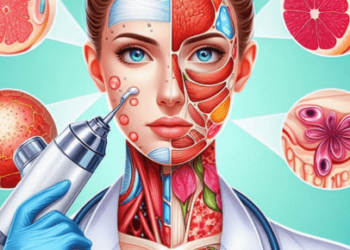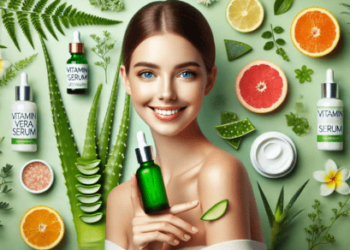
Clear skin is something that many people strive for, as it’s often associated with good health, youth, and beauty. Whether you’re dealing with acne, blemishes, or other skin concerns, understanding the best practices for maintaining clear skin can make a significant difference in your skin’s appearance and overall health. This article will delve into proven methods, lifestyle changes, and skincare tips that can help you achieve clear, glowing skin.
What Is Clear Skin?
Clear skin refers to a complexion that is smooth, blemish-free, and free from visible signs of skin irritation or conditions such as acne, blackheads, or redness. While everyone’s skin is different, the goal of achieving clear skin usually involves maintaining a balanced, healthy skin barrier, which can prevent breakouts and other imperfections.
Factors That Affect Your Skin
Before diving into the steps for clear skin, it’s important to understand the factors that influence your skin’s health. Several internal and external factors contribute to skin conditions:
- Hormones: Hormonal fluctuations during puberty, pregnancy, or due to conditions like polycystic ovary syndrome (PCOS) can cause breakouts and other skin issues.
- Diet: What you eat can significantly impact your skin. Diets high in processed foods, sugar, and dairy have been linked to acne flare-ups.
- Stress: High levels of stress can increase cortisol levels, leading to inflammation and breakouts.
- Genetics: Some individuals are predisposed to certain skin conditions due to their genetics.
- Environmental Factors: Exposure to pollutants, humidity, and UV rays can damage your skin and lead to acne or premature aging.
Skincare Tips for Achieving Clear Skin
Now that we understand the factors that affect skin health, let’s dive into actionable skincare tips to help you achieve clear skin.
1. Establish a Consistent Skincare Routine
One of the most important steps in achieving clear skin is to establish a consistent skincare routine. A well-balanced routine helps cleanse, exfoliate, and hydrate the skin, addressing both surface-level issues and deeper concerns.
- Cleansing: Use a gentle cleanser that suits your skin type. For example, those with oily skin should opt for a gel-based cleanser, while those with dry skin may benefit from a creamy cleanser. Cleansing twice daily—once in the morning and once before bed—is essential to remove dirt, oil, and impurities that can clog pores.
- Exfoliation: Exfoliating your skin 1-2 times a week helps remove dead skin cells and promotes cell turnover, preventing clogged pores that can lead to breakouts. Use a chemical exfoliant with AHAs or BHAs for gentle exfoliation.
- Toning: A toner can help balance your skin’s pH levels and remove any residual makeup or cleanser. Look for toners that are alcohol-free to avoid over-drying the skin.
- Moisturizing: Even if you have oily skin, don’t skip moisturizer. Look for lightweight, non-comedogenic formulas that hydrate without clogging pores.
- Sunscreen: Protecting your skin from harmful UV rays is crucial for maintaining clear, healthy skin. Use a broad-spectrum sunscreen of at least SPF 30 every day, even on cloudy days.
2. Choose Non-Comedogenic Products
When shopping for skincare and makeup, it’s essential to choose products labeled as “non-comedogenic.” These products are formulated to avoid clogging pores, which can lead to acne and breakouts. Whether it’s foundation, moisturizer, or sunscreen, always check the label to ensure it’s non-comedogenic, especially if you have acne-prone skin.
3. Hydrate, Hydrate, Hydrate
One of the simplest and most effective ways to maintain clear skin is by drinking plenty of water. Hydrating your body helps flush out toxins and keeps your skin well-moisturized, reducing the risk of dryness, irritation, and breakouts. Aim for at least 8 glasses (2 liters) of water a day, and include hydrating foods like cucumbers, watermelon, and leafy greens in your diet.
4. Adopt a Balanced Diet for Clear Skin
A healthy diet plays a significant role in achieving and maintaining clear skin. Some foods can help nourish the skin, while others may trigger inflammation and breakouts. Consider these dietary tips for clearer skin:
- Increase antioxidants: Foods rich in antioxidants, such as berries, nuts, and green leafy vegetables, help fight inflammation and oxidative stress, promoting healthy skin.
- Consume healthy fats: Omega-3 fatty acids found in fish like salmon, as well as walnuts and flaxseeds, can reduce inflammation and help maintain a clear complexion.
- Cut back on sugar and dairy: High sugar intake has been linked to acne breakouts. Dairy products, particularly skim milk, have also been associated with acne in some individuals. Try reducing your intake of these foods to see if it improves your skin.
- Incorporate more fiber: Fiber helps regulate digestion and can reduce bloating and skin breakouts. Whole grains, vegetables, and legumes are great sources of fiber.
5. Manage Stress Effectively
Stress is one of the biggest contributors to skin problems. When you’re stressed, your body releases cortisol, a hormone that can lead to inflammation and breakouts. To achieve clear skin, it’s essential to find ways to manage stress. Consider practices like yoga, meditation, deep breathing exercises, or even regular exercise to help lower stress levels and improve your skin’s appearance.
6. Get Enough Sleep
Sleep is essential for overall health, and it plays a crucial role in achieving clear skin. During sleep, your body repairs and regenerates skin cells, which is why getting at least 7-8 hours of sleep per night is vital for maintaining healthy, glowing skin. Lack of sleep can lead to an increase in cortisol levels, which can trigger skin flare-ups.
Professional Treatments for Clear Skin
While following a skincare routine and adopting a healthy lifestyle is essential, some individuals may seek professional treatments to accelerate the process of achieving clear skin. Here are some options to consider:
1. Facials and Chemical Peels
A facial can help cleanse the skin deeply, remove impurities, and provide hydration. Chemical peels, on the other hand, exfoliate the skin and improve its texture. Both treatments are great for individuals dealing with acne scars, pigmentation issues, or uneven skin tone.
2. Laser Treatments
Laser treatments like fractional laser or laser resurfacing can help reduce acne scars, pigmentation, and even fine lines, leading to smoother and clearer skin. However, these treatments should only be done by licensed professionals to ensure safety and effectiveness.
3. Microneedling
Microneedling involves using tiny needles to create controlled skin injuries, which promotes collagen production and helps improve the texture and tone of the skin. This treatment is particularly effective for acne scars and enlarged pores.
Conclusion
Achieving and maintaining clear skin involves a combination of good skincare practices, healthy lifestyle choices, and sometimes professional treatments. Consistency is key—by following a well-rounded skincare routine, eating a balanced diet, staying hydrated, and managing stress, you can enjoy healthier, clearer skin. While it’s important to remember that clear skin looks different for everyone, these tips can help you achieve your best complexion yet.












